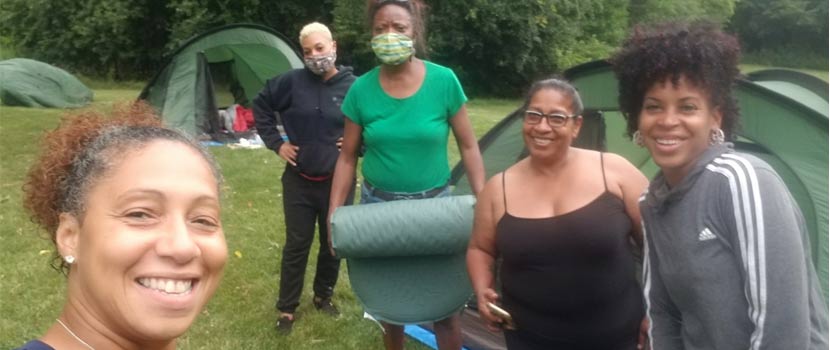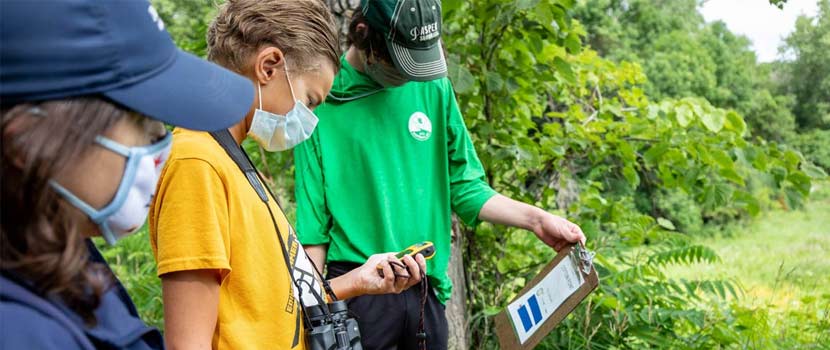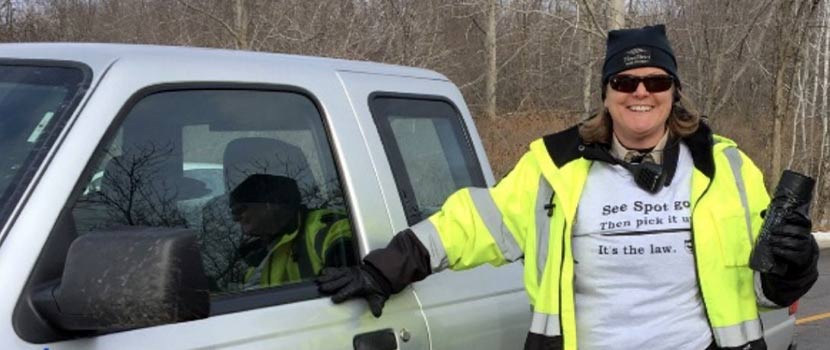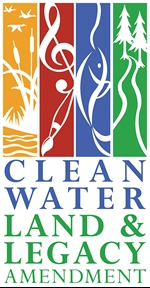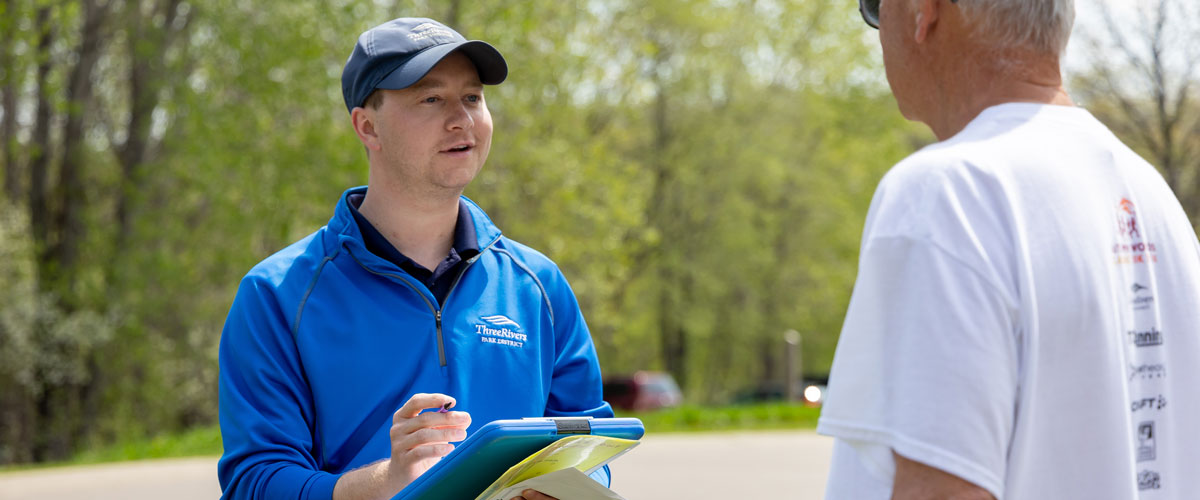
Improving Parks Through Data: My Experience as a Researcher in the Parks
By: Tyler Thompson
June 07, 2023
Category: People of the Parks
When I tell people I do park research the first thing that often comes to their mind is science. They often think of biological research on ecosystems, plants, animals or other areas of natural resource management throughout our park system. Most are surprised when I explain that I study human visitors. This includes the number of people using our parks, what activities they are doing, where they come from, what they like or dislike about our parks and trails, and everything that surrounds the visitor experience.
The biological research that Three Rivers’ natural resources staff in forestry, wildlife and water resources do is a core part managing the Park District’s vast natural resources. And while that research is critical to our mission, it’s also important for us to have a good understanding of the people who visit our parks.
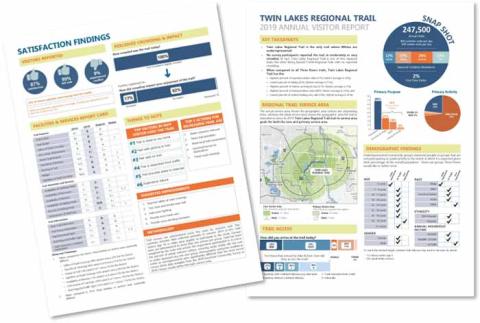
Visitor research is common at federal agencies like the National Park Service but is much less common among local and regional agencies. That makes our work very specialized and unique to Three Rivers Park District. While the Metropolitan Council oversees aspects of research for the entire metropolitan regional parks system, out of the 10 total park agencies in the Metropolitan Council, we are the only regional park agency in the metropolitan area that has dedicated research staff and conduct our own independent research on our park and trail system. Having quality data that is representative to our park system and individual park and trail units is very valuable.
Who We Are and What We Do
The research section includes a small team of three permanent staff, 10 to 15 seasonal staff, more than 20 volunteers, and much assistance from employees across the park district. Our work is varied, detail-oriented, statistically significant (pun intended) and incredibly interesting. What I find most exciting, is that it all relates back to improving the visitors experience and providing our staff with the best possible data to make informed decisions for our parks.
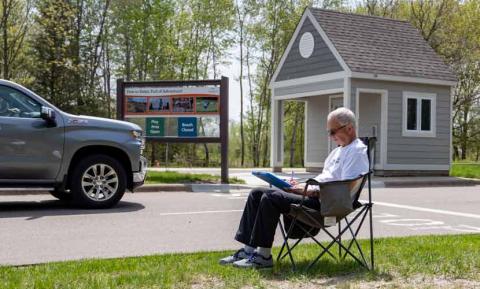
Estimating Number of Visitors
One of research’s three primary tasks is estimating the number of visitors using our parks and trails. Each summer, research staff and volunteers conduct 16 two-hour observation counts at park and trail entrances for every park and regional trail in our system. In total, that is more than 600 visitor observation counts and 1,200 hours, which span the more than 550 different access points to Three Rivers parks and trails. The count locations vary from the main vehicle entrance at a park to a trail connection from an adjacent neighborhood.
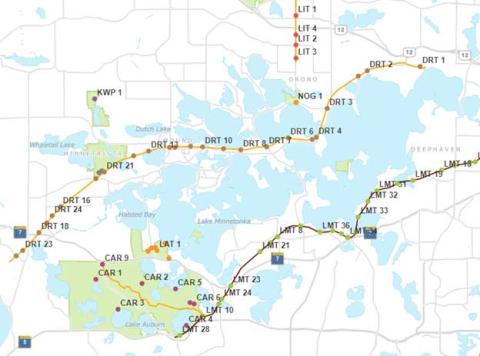
Visitor observations occur on random dates throughout the summer between 8 AM and 8 PM. Each observation is used to determine an estimated number of visitors to each park and regional trail.
In addition to this data, we also utilize electronic vehicle counters at park entrances, bike and pedestrian counters on regional trails, and sales data obtained from our point of sales system (for example, the number of golf rounds played or tubing passes sold) to create a full picture of the visitors to the parks and trails.
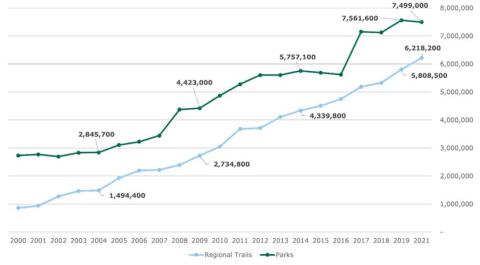
How many annual visitors does Three Rivers Park District receive?
Estimated visitation has increased annually for more than 20 years. In 2021, there were nearly 14,000,000 estimated visits to Three Rivers Park District parks and trails. About 45% of these visits occur on the regional trail system, which spans 180 miles.
Which Three Rivers Park and Regional Trail receive the most visits?
Elm Creek Park Reserve is the most visited Three Rivers Park with 1.5 million annual visitors, followed by Hyland Lake Park Reserve with 1.1 million annual visitors.
The Medicine Lake Regional Trail is the most visited regional trail with 669,000 annual visitors, followed by the Lake Minnetonka Regional Trail with 625,000 annual visitors.
Conducting Visitor Surveys
We also conduct four different visitor surveys, which give us a better idea of who is visiting. We do each of these surveys every five years. These surveys cover regional trail visitors, golf visitors, winter park visitors and summer park visitors. Visitor surveys help staff learn about park visitors and their use-patterns including how far they travel to visit a park, how long they stay, the activities they do, how safe they feel, what suggestions they have for park improvements and their demographics. All this information helps Park District staff ensure that we are providing the best possible park experience for all visitors. When conducted, surveys are distributed at randomly selected times to visitors. Participation in each survey is optional and each survey question is optional.
This year, we will be conducting our summer park visitor survey between June and August 2023. Research staff will survey more than 5,000 visitors at every Three Rivers Park. If approached by a survey staff member in the parks this summer, we encourage you to participate and share your experience. Your input can have an impact on the future of the park.
Part of my job is to read every single comment from each survey during the data analysis process. Your feedback matters, but changes may not come during the same season or even the next year. Implementing changes based on the survey results takes time. The process to gather all the data, ensure it is accurate, and properly organized for analysis takes many months to complete. Data from the visitation estimates are also used to ensure the survey results are representative of all park users. When the entire analysis is complete, results and recommendations are presented to staff across the organization.
Special Projects
The third priority for research staff is working on a variety of other research projects to support staff in the parks and mitigate operational challenges. One common project that staff work on involves determining the frequency and use of parking lots at different areas of parks. This information helps staff identify the highest priority areas to make future capital investments while improving the visitor’s experience.
Doing this work involves many different tools. Staff utilize various methods of technology including geographic information systems, statistical analysis software, electronic vehicle counters and bike/pedestrian counters. As technology changes, our work will continue to change and evolve as well.
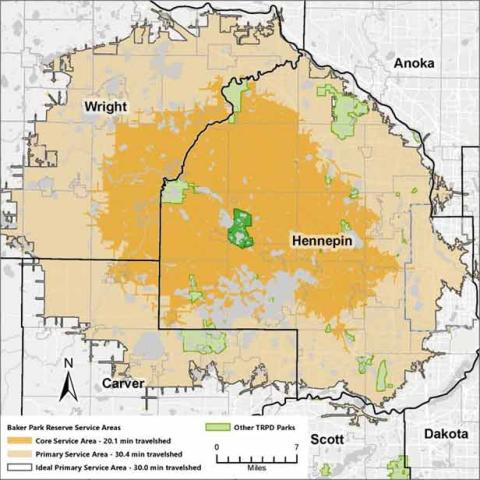
Why We Research
All of our research helps staff improve park and trail operations and improve the visitor experience for park and trail visitors. Additionally, our research provides critical information for park and trail long-range plans so that we can serve growing populations; local, state and federal grant applications that fund park and trail improvements; and planning for the annual budget and capital improvement program helping us to prioritize projects.
One of the largest impacts our research has had on the organization and community members was the focus on better serving all residents of suburban Hennepin County. Results from the 2013 summer park visitor survey indicated that people of color, households with annual income of less than $50,000, and people 75 years or older used our parks and trails less frequently than others. Because of these findings, Three Rivers established its Community Engagement department to introduce new visitors to our parks, formed new partnerships with first-ring cities, made additional improvements to its partnership parks, and set new goals in its 2040 system plan.
Visitor research is just one way Three Rivers leads by example. It plays a role in the day-to-day operations of our parks and trails, as well as the future and long-term planning, helping us meet our 2040 vision of connecting everyone to nature every day.
If you are interested in supporting our work, you can become a volunteer and help with our observation counts by emailing Tyler.
About the Author
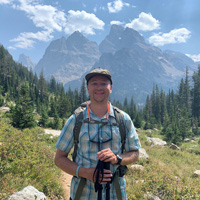
Tyler is a research and evaluation analyst in the planning department at Three Rivers. Previously he was a recreation program specialist with the Outdoor Recreation School (ORS) and a facility supervisor at various parks around the Park District. He graduated from Saint John’s University with a degree in environmental studies and economics.
In addition to sharing his passion for data with his co-workers, he also enjoys sharing his passion for winter and coaching cross-country skiing. He is an avid cross-country skier, canoer, camper and mountain biker, and loves to explore the vast public lands across Minnesota and the country. When he is not exploring the outdoors, he enjoys cheering on Minnesota sports teams, reading books by Minnesota authors and cooking delicious meals at home.
Related Blog Posts
Nature Calls Each of Us: My Experience as a Cultural Liaison
By: Nicole Fernandez
Nicole Fernandez, cultural liaison at Three Rivers, finds joy in connecting others to the outdoors. Learn what draws Nicole to nature, and read about some of her favorite experiences connecting BIPOC (Black, Indigenous, and People of Color) community members to the parks.
This year has presented unique challenges for educators around the world. Learn how one of our environmental educators adapted to teaching in the pandemic and what new strategies she used to benefit her students.
A Day in the Life: Park Service Assistants
By: Alyssa Schauer
Meet one of our staff, Lori Lindahl, and discover a day in her life as a Three Rivers Park Service Assistant.
